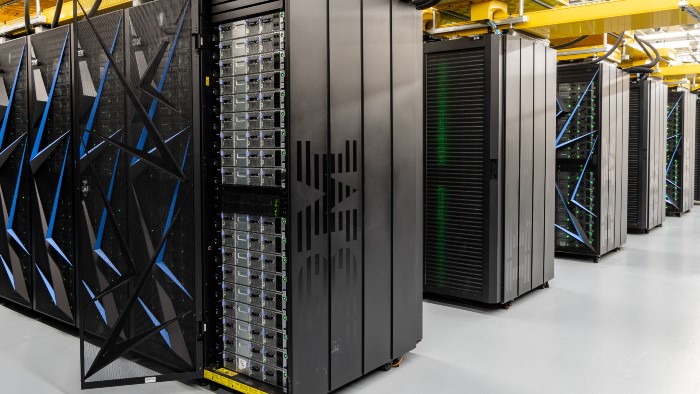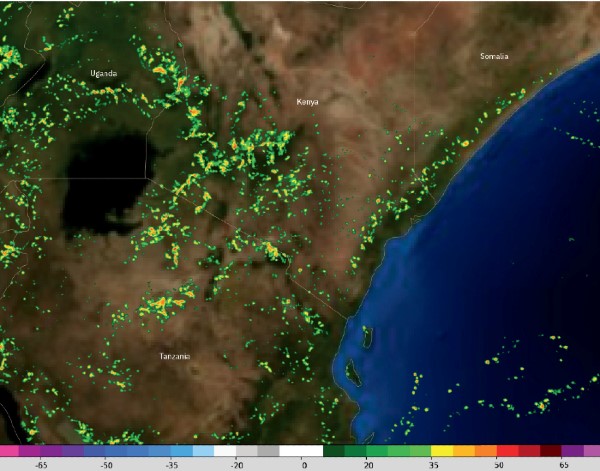Supercomputing
New Advances in Green IT
April 24, 2020 | Written by: David Turek
Categorized: COVID-19 | Supercomputing
Share this post:

The U.S. Department of Energy’s Oak Ridge National Laboratory Summit supercomputer. (Credit: ORNL)
What does COVID-19 have in common with climate change? Supercomputers are an important tool in fighting both of them.
In collaboration with the White House Office of Science and Technology Policy and the U.S. Department of Energy and many others, IBM helped launch the COVID-19 High Performance Computing Consortium, which assembled massive supercomputing power to help researchers better understand COVID-19, its treatments and potential cures.
IBM’s Summit, the most powerful supercomputer on the planet, has already enabled researchers to screen 8,000 compounds to find those that are most likely to bind to the main “spike” protein of the coronavirus, rendering it unable to infect host cells, They have identified 77 small-molecule compounds, such as medications and natural compounds, that have shown the potential to impair COVID-19’s ability to dock with and infect host cells.
The same kind of supercomputing might is being deployed to develop solutions that can help mitigate climate change:
- New chemical compounds that can lead to cleaner fuels with fewer emissions
- More aerodynamic airplane wings and cars that need less fuel to travel farther
- More efficient batteries that can store more energy longer for use in solar power and other energy storage environments
- Weather forecasting like IBM GRAF, which can help farmers better plan their irrigation schedule, reducing water consumption while improving crop yields

IBM GRAF brings higher resolution and more frequent forecasts to places like Kenya.
That’s not all. While the large-scale computing systems needed to advance the effectiveness of AI have often consumed a lot of electricity, IBM has pioneered a new generation of energy efficient supercomputers. In fact, IBM systems took six of the top 10 slots for this year’s Green500, which measures the energy efficiency of the world’s top supercomputers. Each of our top three systems reduces energy consumption in a unique and innovative way:
- Heterogeneous Structures: The AiMOS computer at Rensselaer Polytechnic Institute, No. 3 on the list and the most powerful new supercomputer on the semi-annual TOP500 ranking, has struck a balance between two different computing frameworks – Central Processing Units (CPU) and Graphics Processing Units (GPU) – to maximize both power and energy efficiency. This computer was unveiled in December 2019 as part of a partnership among IBM, Rensselaer and the State of New York.
- Measuring Carbon Emissions for Software: Satori, a new IBM POWER9 supercomputer at MIT, has implemented a first-of-its-kind carbon calculator that estimates the carbon emissions for individual workloads. This gives researchers new insight into how individual applications on a supercomputer can be optimized. MIT recently hosted a Green Hackathon where researchers used this insight to increase the efficiency of their applications – establishing a blueprint for becoming more efficient by using smarter software.
- Water Management: Summit, based at the Oak Ridge National Laboratory, is among the world’s most powerful supercomputers. It uses a unique self-regulated water cooling system that tops up automatically. The system can understand the causes of temperature fluctuations in its water supply and optimize settings to increase energy efficiency.
Supercomputing and AI will speed the discovery of solutions to current and future crises in climate, medicine and public health. Achieving these advances while contributing as little as possible to climate change must be a critical component of our goals to improve the way we live through the responsible use of technology.

Vice President of Technical Computing for IBM Cognitive Systems
Shifts in U.S. Consumers’ Preferences Amid COVID-19 Make Business Agility Essential
As we move through the pandemic, and states and businesses in the United States begin to carefully re-open, U.S. consumers’ attitudes toward life and work are continuing to evolve, according to new research from the IBM Institute for Business Value (IBV). The IBV polled more than 18,000 U.S. adults in May and early June to […]
Igniting the Dynamic Workforce in Your Company
In the rapid push to moving to remote work, we’ve seen digital strategies accelerate by years – transforming their workplaces, workstyles, and business processes forever. Overnight, remote workforces put advanced environments of multi-device mobility, dynamic connection points and robust cloud-based apps that ease communication and collaboration. A new normal is emerging, led by the companies aggressively adopting cloud […]
Lessons from Space May Help Care for Those Living Through Social Isolation on Earth
Since the Crew Dragon spacecraft arrived at the International Space Station (ISS) on May 31, NASA astronauts Bob Behnken and Doug Hurley have been busy—according to their Twitter posts, even working over the weekend to repair the ISS treadmill. They likely don’t have much time to think about being lonely and cut off from life […]





























